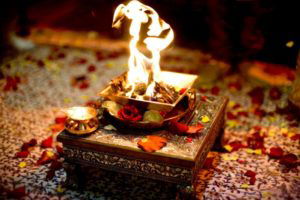Fire in non-Christian Religions
How do the non-abrahamic religions view fire?

How do the non-abrahamic religions view fire?


Article originally posted on Mission Kaali
A story:
“Once a Christian tried to convert a Hindu. The Christian said ‘If you do not accept Jesus as your savior, you will burn in hell!’. The Hindu seemed unfazed, and asked the Christian ‘What is in hell that we have to be afraid of?’. The Christian replied ‘Fire, lots of fire’. The Hindu, still unconvinced of the terrible nature of hell, replied ‘In Bharat, we stroll on hot fire. We immolate our bodies on fire. Fire is part of the universe. We see Brahman in the offering to the fire, in the fire itself, and in the one we are offering to. So what is so bad about fire?’. The Christian had no response.”
Fire has been an integral part of dharmic rituals from the early days. All stages of life, there is usually at least one homa that takes place. Vedic fire ceremonies, also known as yajna, have been a part of Sanathan dharma since the beginning, and are still carried out to this day.
Fire rituals are also part of many other non-Abrahamic religions, such as Zoroastrianism. Zoroastrians will stand in front of a fire in their home space or in their temples (known as fire temples) and will chant their own verses.
Fire rituals are important to the various indigenous peoples of North and South America. Often, the native tribes (such as the Plains and Plateau tribes in Montana, USA) will keep a fire going for 24 hours or more, have dancers dance around it dressed in their regalia, and burn herbs such as cedar and sage. Throughout the 19th and 20th centuries, the government of the USA suppressed these indigenous traditions while actively using missionaries as their enforcers. Even so, indigenous peoples have kept up many of their spiritual practices, even if some of them have been diminished due to their forced conversion to Christianity. It is our hope that indigenous tribes in North and South America can shed Christianity and embrace more of their traditional spiritual practices in full.

So why is a Christian scared of the fires of hell? Shri Rajiv Malhotra provides an insight into the forces that have shaped the mindset of Christianity and of Christians:
“It is the milieu of the desert, on the other hand, that has shaped the Abrahamic faiths. The desert can be hostile and is not a place to dwell permanently, or to marvel at the diversity of life […] The desert connotates starkness, a paucity of life, harsh environs and danger. The Judeo-Christian ethos is built on this sense of scarcity and fear”
So it should be no surprise that the early semitic people who formed Judaism, from which Christianity originates from, think that hell is a very hot, punishing, inhospitable place. While paradise for them is just the opposite. Christians have also long depicted hell as a place full of fire and brimstone; brimstone is sulfur dioxide. That too has origins in the early semitic peoples’ civilization, as the god yahweh was originally one of many of their gods. Yahweh was the god of metallurgy at first, and was among a pantheon of gods of the Canaanites. Metal weapons were forged with fire and sulfur dioxide, aka brimstone.
Over time, yahweh became the only god of the Israelites, who were one of the Canaanite tribes.
So next time a Christian, be it a friend, a classmate, a pastor, or a missionary going door to door tell you you will burn in the fires of hell, keep in mind where he or she comes from. And that they don’t know any better about how fire is regarded in the dominant culture (even though they may be born and raised among the dominant culture), or about the origins of the Christian fear of fire. Sure, give them pushback as the unapologetic Sanathani does in the story, but also, feel pity for them. They have not done this kind of analysis of their assumptions.
DISCLAIMER: The author is solely responsible for the views expressed in this article. The author carries the responsibility for citing and/or licensing of images utilized within the text.
